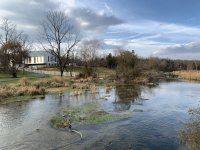silverfox
Well-known member
- Joined
- Oct 4, 2006
- Messages
- 1,928
My issue with the wild native brook trout enhancement program and the resulting manuscript is that the stated goal was to increase the number of >100 to >175mm fish in short sections of 2nd order streams via C&R regs (with no gear type changes) while publishing the locations, which likely resulted in increased angling pressure, which likely increased incidental hooking mortality. With the exception of Kettle Creek, all failed to achieve the stated goal.There were not just three streams in the Pa ST special regs study. There were more, but it happens that the AFM for the Poconos region chose the three in his region for a regional web report. The final results of the multi-regional study were published, as I recall, in an American Fisheries Society journal. Furthermore, changes in micro-habitat at any one sampling site in a study like that are absorbed and accounted for by having multiple treatment streams and multiple control streams under study across a broad geographical area and multiple years. To show significant differences pre and post regulation between treatment and control streams, there needs to something more than natural variation occurring. Annual changes in habitat due to storms, etc are examples of natural variations, as are variations in year class strengths. This study was conducted across more than one generation of ST as well.
Regarding the ST genetic similarities among streams in the Loyalsock study, see third paragraph in the PSU article topic: Larger streams are critical to wild brook trout conservation.
I fully agree that maintaining passage through stream and river corridors is important. If I didn’t, I would not have been nearly as professionally active as I was in pressing for fishway development and dam removals, including removals specifically aimed at wild trout. In fact, some of those are still in the process of moving forward.
As for the need to have the same high genetic diversity in each ST stream in a given drainage, I’m not that much of a splitter. In fact a recent study in WV, if I recall the proper state, showed ST genetic differences among short segments of individual streams. I am satisfied at the moment to have high genetic diversity within a drainage and good connectivity such that when a catastrophic event occurs the pre-adapted individuals that survive in one stream can eventually contribute offspring to other streams via movement. This happens already in Pa following recoveries from drought and various causes of pollution that resulted in localized extirpation.
As for overharvest in Pa trout streams, localized overharvest at a popular bridge or where a forest road comes closest to a stream is not statewide or streamwide overharvest. I have on multiple occasions for a decade or more asked individuals here to name streams where the overall Wild trout population is overharvested and with only one exception, all that I have heard have been crickets. The statewide angler use and harvest study showed that this is not a statewide problem and the more localized, but still regionally diverse study of special ST regs, showed the same thing.
It's not, or shouldn't be, about increasing the number of >100 to >175mm adults. It should be about protecting important fish within the population. These are wild native self-sustaining populations of highly sensitive fish listed as a species of greatest conservation need in Pennsylvania, not hatchery fish or wild nonnative fish. They should deserve more respect and protection than other salmonid resources in my opinion.
Again, I think it should be about eliminating as many negative impacts on the populations as possible. Barrier removal, habitat improvement, water quality improvement and protection, and in my opinion, harvest regs, and favoring the removal of competing nonnative salmonids should be included in that list. Again, these are things that are easy, free, and already being implemented by other states in the native range.
Bob's creek Bedford County is the worst in my opinion. Between displacement, stocked trout, and over-harvest, the brook trout population there has been largely decimated over the last 30 years. Piney Run, Cub Run Somerset Co. Clear Shade Creek headwaters, Ben's Creek, Upper Cove Creek, Bells Gap, Blair Gap Run, Beaverdam Creek & South Poplar Run. There are some streams near me where I believe the brook trout have been either decimated, or severely cropped due to stocking, harvest, and nonnative salmonids. All of those streams, with the exception of Bobs are likely low Class B or lower in most stocked stretches. However, almost all are "drop-back" sections where the brook trout need that winter habitat and where the ST are in the spring when buckets of nonnatives and an onslaught of springtime anglers bombard the fish. I'm sure the stocked sections didn't survey well in late August when the temps were at their highest. Again, watershed level vs the current management approach.





